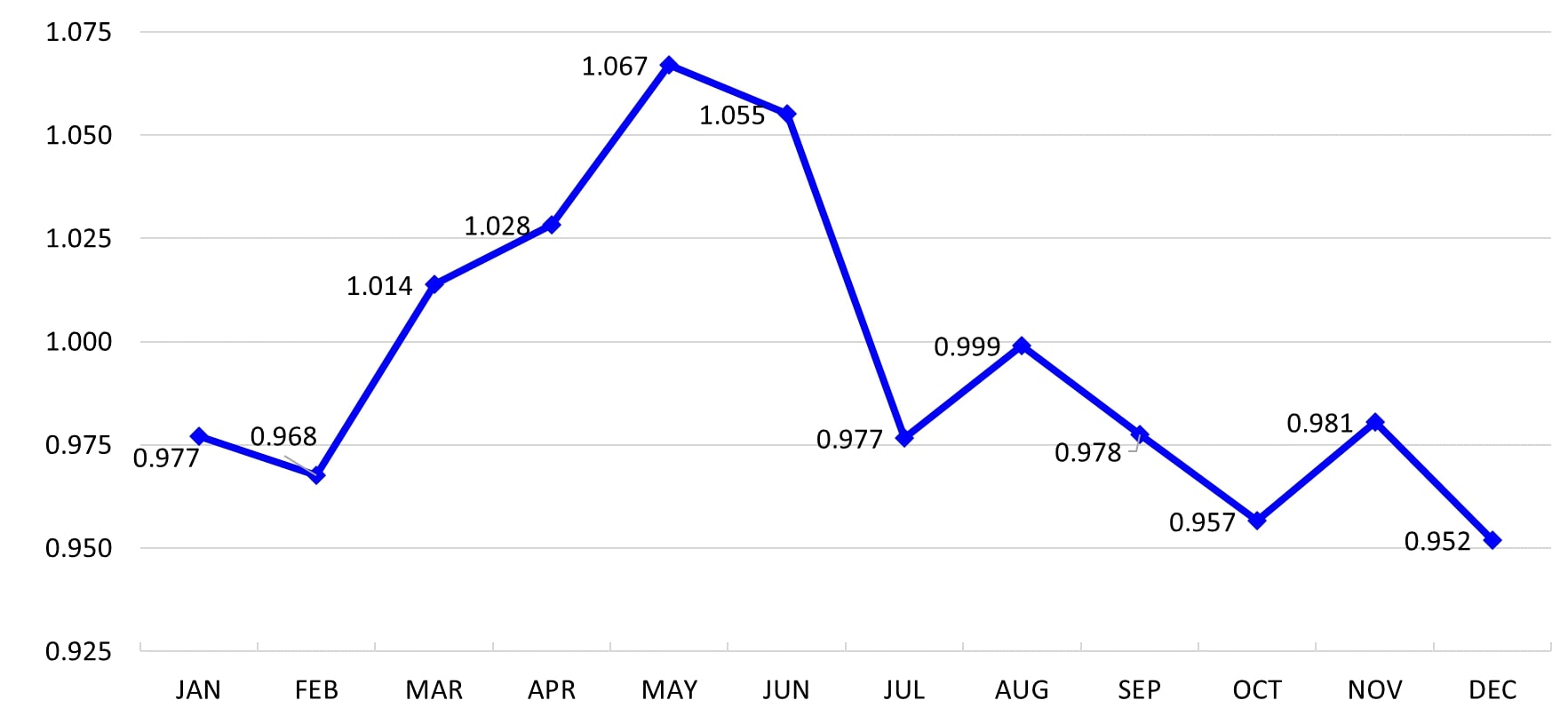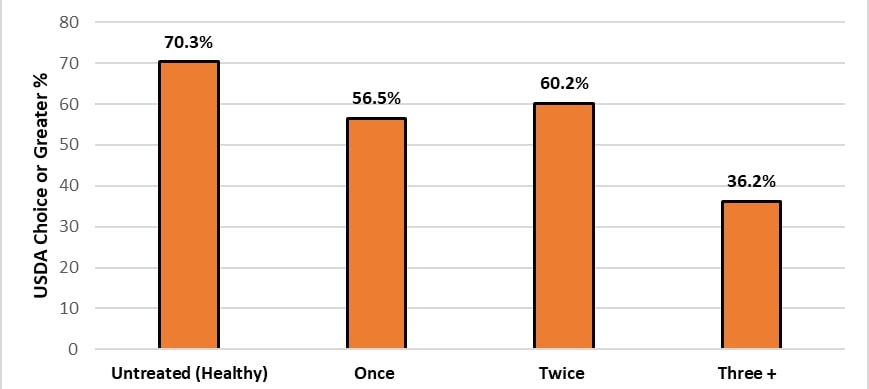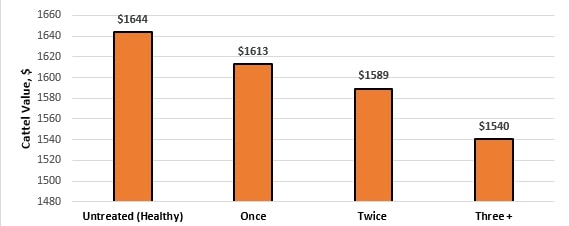Cow-Calf Corner | May 8, 2023
Summer Grilling Season is Near
Derrell S. Peel, Oklahoma State University Extension Livestock Marketing Specialist
May is upon us with all the weather uncertainty that is typical of the month but also the assurance that summer is coming. The Memorial Day holiday at the end of the month will kick of the summer grilling season. Lots of attention is being focused on beef demand as the tightening of beef supplies will increase the pressure for higher wholesale and retail beef prices. How high can they go and how fast?
In the first full week of May, Choice boxed beef prices averaged $309.41/cwt., up over 9 percent from the beginning of the year and 20 percent higher year over year. The boxed beef price increase thus far in 2023 is following quite close to an average seasonal pattern as shown in Figure 1. Boxed beef prices typically peak in May with wholesale buying ahead of summer grilling season, before dropping lower in the second half of the year. The seasonal pattern of boxed beef prices reflects the net impact of seasonal demands for the various beef products that are included in the boxed beef price as reported by the Agricultural Marketing Service (USDA-AMS). Current daily boxed beef reports include prices for more than 40 different beef cuts and subprimals. The price seasonality of each of these products varies according to the different uses of the products and the alternative supply chains in which they are mostly marketed. Beef products may flow primarily through the supply chains of retail grocery, food service (including restaurants) or export markets. Nearly all of the reported wholesale beef prices are currently higher year over year.
Figure 1: Choice Boxed Beef Seasonal Index, Monthly, 2012-2021 average.
*May 2020 removed from the index due to COVID distortions.
The May peak in boxed beef price is largely driven by retail grocery demand for Strip Loins and Sirloin cuts that move primarily through retail grocery channels. Chuck Roll prices are also very strong currently, which may be driven by export demand and retail grocery demand, including ground beef. The most valuable cuts of Tenderloin and Ribeye are not typically seasonally strong this time of year, but both have been higher all year so far in 2023, reflecting continued strong restaurant demand.
Ground beef demand typically increases in the summer, not only because of grilling demand but also because more people are traveling and utilizing drive-throughs. Food service ground beef demand, especially the Quick Service Restaurants (QSRs), really heavily on beef trimmings as sources for ground beef production. The price of 90 percent lean trimmings (mostly cow beef), have beef rising all year and are currently moving higher than year ago levels. More dramatically, the price of 50 percent lean trimmings has moved sharply higher to a current level that is unprecedented except for a brief spike during the pandemic in 2020.
Tightening beef supplies, underlying general strength in beef demand and seasonal grilling demand are all pushing wholesale beef prices higher. Consumer beef demand has continued to be remarkably resilient and wholesale beef prices are likely to go higher yet as beef production continues to decrease going forward.
Selection of Replacement Heifers - Reproductive Tract Scoring – Spring 2023
Mark Z. Johnson, Oklahoma State University Extension Beef Cattle Breeding Specialist
In a normal year in Oklahoma, sometime during the spring, replacement heifers would be selected from the yearling females coming off wheat pasture. Individual producers selection criteria and breeding objectives would determine which heifers were to be retained. It would be safe to assume most heifers coming off wheat pasture would have achieved a target weight of reaching 65% of their mature weight by 14-15 months of age and accordingly, over 90% would be fully pubertal and ready for their first breeding season. At worst (in a normal year), heifers would reach 55% of their mature weight and the majority of those heifers would be ready for breeding. However, the past year or two haven’t been “normal” with regard to precipitation and wheat pasture grazing. As a result producers may be evaluating a group of replacement heifers that are a little behind schedule with regard to target weights and body condition.
If this sounds familiar there is a management tool available that can be very helpful in determining if heifers are ready for breeding. Reproductive Tract Scoring (RTS) is the management tool. RTS is a subjective measurement which involves the rectal palpation of the heifer reproductive tract (uterine horns and ovarian structures) and the subsequent assignment of a reproductive tract score, ranging from 1 to 5 (1 = immature; 5 = presence of a corpus luteum), to assist the producer in making replacement heifer decisions. Since age at puberty is difficult to measure directly, RTS can estimate pubertal status, and if performed before the onset of the breeding season, can be a predictor of heifer reproductive performance allowing for heifers with a poor breeding potential to be removed from the breeding group before any further costs are incurred. The RTS system has been shown to be a repeatable measure between and within practitioners and to be moderately heritable.
A RTS of 1 is refers to a prepubertal heifer, a RTS of 2 or 3 is refers to a peripubertal heifer (transitional stage), and a RTS of 4 or 5 is refers to a pubertal (cycling) heifer. The reproductive performance of heifers with an RTS of 1 or 2 is less than that of heifers with an RTS of 3 or greater. Heifers with a RTS of 1 or 2 are less likely to be cycling at the beginning of the breeding season and therefore are less likely to become pregnant or if they do become pregnant, do so later in the breeding season suggesting that heifers with a RTS of 1 should possibly be eliminated from the breeding group. It is worth mentioning, that some heifers do not exactly fit a particular RTS score and it is up to the producer and/or practitioner to decide on which of the measures are to be given the most emphasis.
RTS should be done about 1 month or less prior to breeding if the score is to be used as a culling tool as an indicator of a heifer's ability to conceive early during the first breeding season. If RTS is to be used as a selection tool to place pressure on age at puberty, the best time to evaluate the heifers is when approximately 50% of the heifers are thought to be cycling based on age, weight, and occasional observations for estrus.
Another possible application of the RTS system is to assess the nutritional program being utilized by the producer. If RTS is taken within a sufficient time before the start of the breeding season (approximately 30 to 60 days); based on the results of the tract scores, the producer can adjust the ration to help the heifers reach developmental goals prior to the beginning of the breeding season or the beginning of the breeding season can be adjusted.
Consult with your Veterinarian about RTS. It can be informative and beneficial in the selection process of yearling replacement heifers.
References:
Chapter 29 OSU Beef Cattle Manual, Eighth Edition
Stein, Dan. Reproductive Tract Scoring, Cow-Calf Corner, May 2021
Dr. Mark Johnson and Dr. Dan Stein discuss the process of reproductive tract scoring in cattle on SunUpTV from June 5, 2021.
Beef Calf Preconditioning Practices Improve Calf Health while Increasing Performance and Carcass Quality
Paul Vining, Oklahoma State University Cooperative Extension Service OQBN Coordinator
Calves enrolled in the OQBN Vac-45 Program attained an average market premium of $18.67/cwt in 2022 and an average of $13.06/cwt over the past 12 years, compared to similar nonpreconditioned calves in the same sales. Common beef calf preconditioning practices include weaning calves for 45 days or more, providing vaccinations for clostridial bacteria (blackleg) and bovine respiratory disease (BRD), castrating, dehorning, and bunk training. Implementing these practices bolsters the immune system, allowing calves to remain healthy during the rigors of the stocker and feedlot phases.
It has been shown that healthy calves usually outgain sick calves during the beginning of the feedlot period (4 to 6 weeks). A study by Richeson et al., (2012) indicated that upon entering the feedlot, preconditioned beef steers exhibited an increased average daily gain (ADG) of 0.77 lbs. and a 90% reduction in BRD morbidity (sickness) compared to nonpreconditioned beef steers. Calves that receive medical treatment for BRD may recover and often exhibit compensatory gain, allowing them to achieve similar final body weights compared to their untreated, healthy counterparts. However, medical treatment and additional days on feed increase production costs and decrease profitability. Calves that must be treated for BRD exhibit a decrease in carcass quality compared to healthy, untreated cattle. An Oklahoma State University study by Wilson et al. (2017), indicated that healthy beef calves (not requiring treatment for BRD) graded choice or prime 70% of the time, while calves treated for BRD once, twice, and three or more times, graded choice or prime 56%, 60%, and 36% of the time respectively (Figure 1). Reduced carcass quality results in a decrease in carcass value. Wilson et al. (2017) indicated the average carcass values of calves treated for BRD once, twice, and three or more times were reduced by $31, $54, and $103 respectively, compared to the carcass value of untreated, healthy calves (Figure 2).
Figure 1: The impact of BRD Treatment on USDA Quality Grade, in a 2017 Oklahoma State study. Source: Wilson et al., 2017.
Figure 2: Actual cattle gross income of feedlot cattle treated for BRD, in a 2017 Oklahoma State study. Source: Wilson et al., 2017.
References:
Richeson, J.T., E.B. Kegley, J.G. Powell, P.A. Beck, B.L. Vander Ley, and J.F. Ridpath. 2012. Weaning management of newly received beef calves with or without continuous exposure to a persistently infected bovine viral diarrhea virus pen mate: Effects on health, performance, bovine diarrhea titers, and peripheral blood leukocytes. J. of Anim. Sci. 90:1972-1985.
Wilson, B.K., D.L. Step, C.L. Maxwell, C.A. Gifford, C.J. Richards, and C.R. Krehbiel. Effect of bovine respiratory disease during receiving period on steer finishing performance, efficiency, carcass characteristics, and lung scores. 2017. The Prof. Anim. Sci. 33:24-36.



